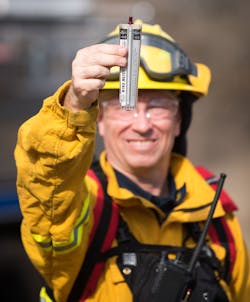Texas Students Get Lessons in Wildland Firefighting
“I had no idea how fast it moves. If you’re in a heavy fuel area, once it starts, it goes...you can lose it pretty quick”
That's the impression that a week-long class on wildland fires left on Kyle Roirdan, a firefighter in Red Oak, Texas, just outside of Dallas.
Roirdan was one of 20 students that attended the week-long North Texas Wildfire Academy put on by Tarrant County College in Fort Worth. The class certifies firefighters to the National Wildfire Coordinating Group S130 and S190 levels, the basics.
“I had no idea the weather had so much impact on wildland fires...humidity, temperature, terrain, fire fuels, fire loads,” he said.
Roirdan's fire chief asked some of the Red Oak firefighters to take the class. His area, which is predominately residential, is covered with low fuel grass.
"These guys are coming out here to learn about fighting fire without using water, which is completely opposite of what we’re used to doing," said Cody Stilwell, the coordinator and lead instructor for the academy.
The academy staff is comprised of Tarrant County College instructors and firefighters who make up the Elm Fork Fire Module, a Type 2 crew that responds statewide for wildfire incidents.
The 130/190 classes require a field trip to observe what is taught in the classroom. They see how weather, topography, fuel and terrain react with each other.
"This was a very unique opportunity for these students," Stillwell said as they burned 19 acres at the Fort Worth Nature Preserve. "It's not often that 130/190 students get live fire in their class."
Firefighters, including a few from Canada, were not the only ones attending.
Wildlife biologist Kara Campbell attended the academy because is it required by her job at Texas Parks and Wildlife.
"It’s been a great class for an introduction to wildland fires," Campbell said. "Learning about fire behavior and learning about the good things to do and the not good things to do..."
She said the information opened her eyes to prescribed burns at parks which falls under her duties at work.
“All the effort that goes into even just planning a prescribed fire is incredible. There’s a lot of coordination and communication that goes on," she said. "Everyone is taking part in it, just not one person."
An instructor at the Kileen Fire Acamdey steered Joseph Kassabian, who is looking to get on a Texas fire department.
“I spent seven years in the military and wildland firefighting reminds me a lot of that. Fighting with the different tools you have and that's it."
At the end of the academy, Kassabian is walking away with a better understanding of fires in the wildland interface.
“I didn't realize that wildland fires have such extreme behavior that it can blow at 70 mph."
